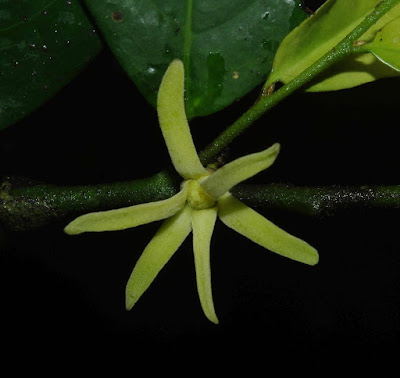![]() |
Centenaria rupacquiana
P.Gonzáles, A.Cano & H.Rob.
in Gonzáles, Cano & Robinson, 2018. |
Abstract
A little herb from central Peru is recognised as a new species of a new genus. Centenaria rupacquiana belongs to the tribe Eupatorieae, subtribe Piqueriinae. It has asymmetrical corollas with two inner lobes smaller, a flat and epaleaceous receptacle and the presence of pappus. In Peru, Centenaria is related to the genera Ferreyrella and Ellenbergia, but Ferreyrella is different by having no pappus and a paleate receptacle; and on the other hand, Ellenbergia is different by having symmetrical corollas.
Keywords: Asteraceae, Ellenbergia, Eupatorieae, Ferreyrella, Rupac
![]() |
| Figure 1. Centenaria rupacquiana. A Plant B leaf (adaxial surface) C mature leaf (abaxial surface) D mature leaf (adaxial surface) E upper leaf F uppermost leaf bracteiform G capitula (upper view) H involucre I inner phyllaries J outer phyllaries K flower (frontal view) L flower (lateral view) M flower tube with glandular trichomes N flower (upper view) O style and stamens P, Q scale of pappus R achene without pappus. Photos by P. Gonzáles. |
Centenaria P.Gonzáles, A.Cano & H.Rob., gen. nov.
Description: Small, erect, annual herbs, to 30 cm tall. Leaves opposite, blade ovate to broadly elliptical, coarsely to finely serrate. Inflorescence a diffuse corymbose cyme. Phyllaries 5, distant, biseriate, subequal to equal, persistent, oblong-elliptical to obovate-elliptical, with shortly apiculate apices; receptacle flat, foveolate, glabrous, epaleaceous. Florets 7–14; corollas asymmetrical with the two inner lobes smaller, white, with distinct short constricted basal tube bearing glandular or eglandular hairs; throat short and broad-campanulate; lobes as long as wide or outer lobes of peripheral florets longer, short-papillose on inner surface and margins; lower part of filament glabrous; anther collars rather short; style base not enlarged, glabrous; arms rather short-clavate, densely short-papillose; papillae larger and less dense below clavate tip. Achenes prismatic, 5-ribbed, ribs setuliferous, narrowed and setuliferous above carpopodium; carpopodium inconspicuously, short-cylindrical; pappus 5 long, lanceolate squamellae, densely scabrid on margins, nearly smooth on outer surface, smooth on inner surface.
Centenaria rupacquiana P.Gonzáles, A.Cano & H.Rob., sp. nov.
Diagnosis: A little herb characterised by its asymmetrical corollas with two small inner lobes, flat and epaleaceous receptacle and presence of pappus.
Type: Peru. Dept. Lima: prov. Huaral, Dist. Atavillos Bajo, NE of Pampas, road to Rupac, archaeological monument pre Inca, slopes with loamy clay soil, scrubland, ..., 3033–3509 m a.s.l., 15 Apr 2018, (fl,fr), A. Cano, P. Gonzáles, E. Huamán, S. Riva & S. Rivera 22682 (holotype: USM-3070016!, isotypes: MO!, MOL!, US-3730645!, USM!).
Distribution: Known only from the type locality in Rupac, northeast from Lima Department.
Ecology: Terrestrial plant growing on open area amongst shrubs, in the western Cordillera shrubland, between 3000–3500 m a.s.l. Co-occurring species include Paracalia jungioides (Hook. & Arn.) Cuatrec., Heliopsis buphthalmoides (Jacq.) Dunal, Dasyphyllum ferox (Wedd.) Cabrera and Vulpia megalura (Nutt.) Rydb. Flowering and fruiting between April and May.
Etymology: The genus is dedicated to the centennial of the institutional foundation of the Natural History Museum of National University Mayor of San Marcos (1918–2018), for their hard work on the research, conservation, preservation and diffusion of the biodiversity of the country. All these actions are steadily increasing our knowledge of the flora and fauna of our native land. The specific epithet refers to Rupac, a small village with archaeological remains from the Atavillos culture, where the only two populations of this species are known from this place.
Paúl Gonzáles, Asunción Cano and Harold Robinson. 2018. A New Genus of Compositae (Eupatorieae, Piqueriinae) from Peru, named Centenaria to honour the 100th Anniversary of the Natural History Museum of the National University Mayor of San Marcos.
PhytoKeys. 113: 69-77. DOI:
10.3897/phytokeys.113.28242
Resumen: Una pequeña hierba del centro del Perú es reconocida como una especie nueva en un nuevo género. Centenaria rupacquiana es miembro de la tribu Eupatorieae subtribu Piqueriinae. Tiene corolas asimétricas con dos lóbulos internos más pequeños, receptáculo plano y sin palea, y presencia de papus. En Perú, Centenaria está relacionada a los géneros Ferreyrella y Ellenbergia, Pero Ferreyrella se diferencia por carecer de papus y presentar un receptáculo con paleas; por otro lado, Ellenbergia se diferencia por sus corolas simétricas.















































































